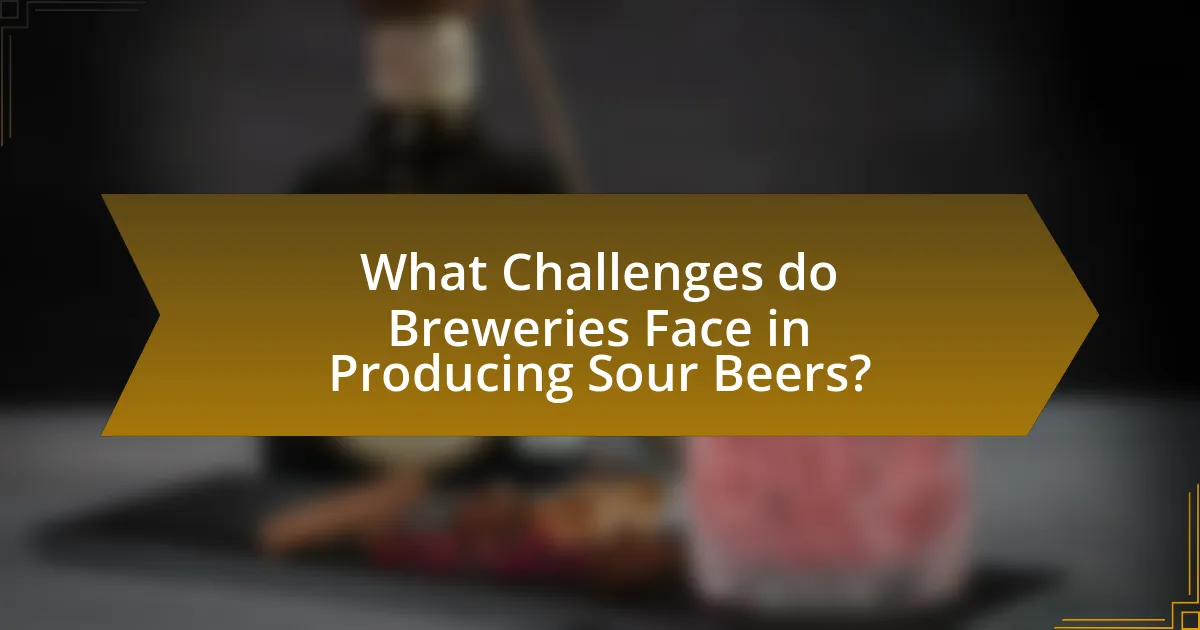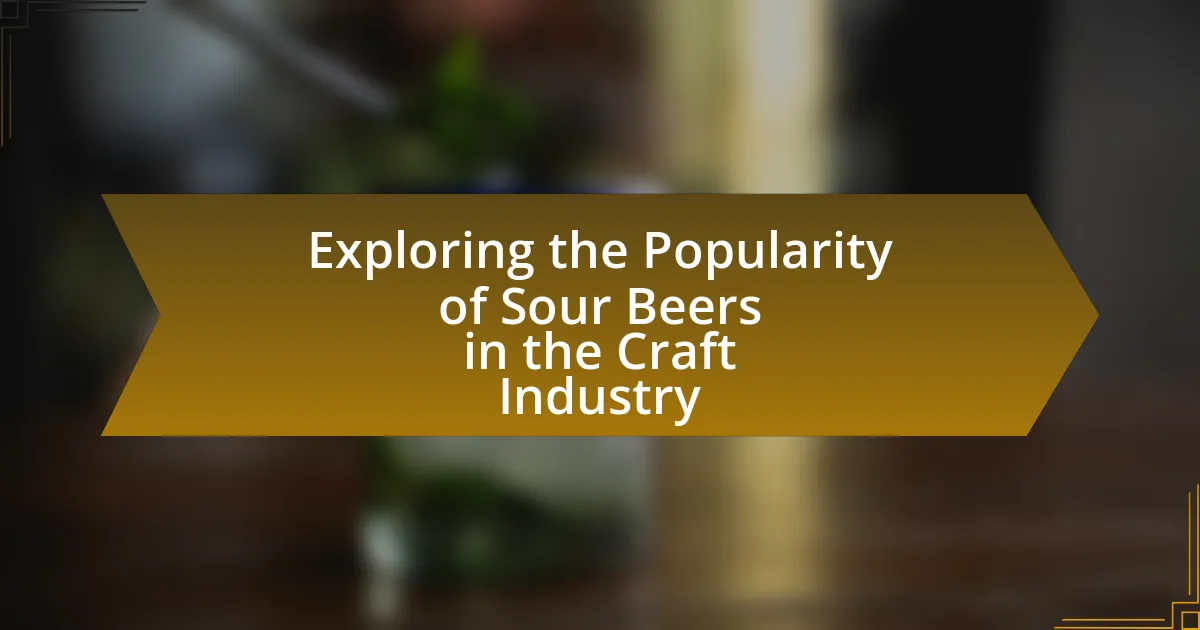Sour beers, characterized by their tart and acidic flavors resulting from wild yeast strains and bacteria fermentation, are gaining traction in the craft beer industry. Their rise in popularity is attributed to consumer interest in unique flavor profiles and innovative brewing techniques, with sour beers accounting for approximately 1% of the craft beer market in 2020. The article explores the differences between sour and traditional beers, the fermentation processes involved, and the ingredients that contribute to their distinct taste. It also examines consumer preferences, the role of craft breweries in sour beer production, and the economic implications of producing these niche beverages. Additionally, the article highlights emerging trends, sustainability practices, and effective marketing strategies for sour beers.

What are Sour Beers and Why are They Gaining Popularity in the Craft Industry?
Sour beers are a category of beer characterized by their tart, acidic flavors, which result from fermentation processes involving wild yeast strains and bacteria, such as Lactobacillus and Brettanomyces. Their popularity in the craft industry is increasing due to a growing consumer interest in unique and complex flavor profiles, as well as the rise of experimental brewing techniques. According to the Brewers Association, sour beers accounted for approximately 1% of the overall craft beer market in 2020, reflecting a significant niche that is expanding as breweries innovate and diversify their offerings. This trend is further supported by the increasing number of craft breweries producing sour styles, which has risen by over 50% in recent years, indicating a robust demand for these distinctive brews.
How do Sour Beers differ from Traditional Beers?
Sour beers differ from traditional beers primarily in their fermentation process, which involves wild yeast strains and bacteria that produce lactic acid, resulting in a tart flavor profile. Traditional beers typically use cultivated yeast strains that ferment sugars without producing significant acidity, leading to a cleaner and more straightforward taste. The use of ingredients like Brettanomyces, Lactobacillus, or Pediococcus in sour beers contributes to their unique sourness and complexity, contrasting with the more balanced and malt-forward characteristics of traditional beers. This distinction in fermentation methods and flavor profiles is a key factor in the growing popularity of sour beers within the craft industry.
What fermentation processes are used in Sour Beer production?
Sour beer production primarily utilizes two fermentation processes: spontaneous fermentation and mixed fermentation. Spontaneous fermentation involves the natural exposure of wort to wild yeast and bacteria present in the environment, particularly in regions like Belgium, where the process is traditional. Mixed fermentation combines both wild yeast strains, such as Brettanomyces, and lactic acid bacteria, like Lactobacillus and Pediococcus, to create complex flavors and acidity. This method is common in modern craft brewing, allowing brewers to control the fermentation environment while still achieving the desired sourness and character in the beer.
What ingredients contribute to the sourness in these beers?
Lactic acid bacteria, wild yeast strains like Brettanomyces, and certain fruits contribute to the sourness in sour beers. Lactic acid bacteria, such as Lactobacillus and Pediococcus, produce lactic acid during fermentation, which imparts a tart flavor. Brettanomyces can also produce various acids and phenolic compounds that enhance sourness. Additionally, fruits like cherries, raspberries, and citrus can introduce natural acidity, further increasing the sour profile of the beer. These ingredients are essential in creating the distinct sour taste that characterizes this style of beer.
Why are Consumers Drawn to Sour Beers?
Consumers are drawn to sour beers primarily due to their unique flavor profiles and the complexity they offer. Sour beers often feature a balance of tartness and sweetness, appealing to those seeking diverse taste experiences. The fermentation process, which includes wild yeast and bacteria, contributes to these distinctive flavors, making sour beers intriguing to craft beer enthusiasts. Additionally, the rise of the craft beer movement has led to increased experimentation with sour styles, further attracting consumers who value innovation and variety in their beverage choices.
What flavor profiles do Sour Beers offer that attract drinkers?
Sour beers offer complex flavor profiles that attract drinkers, including tartness, fruitiness, and earthy notes. The tartness primarily comes from lactic acid produced during fermentation, creating a refreshing and crisp taste. Additionally, sour beers often feature fruity flavors such as citrus, berries, and stone fruits, which enhance their appeal. The presence of wild yeast strains, like Brettanomyces, contributes earthy and funky characteristics, adding depth to the overall flavor experience. These unique combinations of flavors differentiate sour beers from traditional styles, making them increasingly popular among craft beer enthusiasts.
How do trends in health and wellness influence the popularity of Sour Beers?
Trends in health and wellness significantly influence the popularity of sour beers by aligning with consumer preferences for lower-calorie, probiotic-rich beverages. Sour beers, often lower in alcohol and calories compared to traditional beers, appeal to health-conscious drinkers seeking flavorful yet lighter options. Additionally, the fermentation process in sour beers can introduce probiotics, which are associated with gut health, further attracting consumers interested in wellness. This shift is supported by market research indicating a growing demand for functional beverages, with sour beers increasingly recognized for their unique flavors and potential health benefits.
What Role do Craft Breweries Play in the Rise of Sour Beers?
Craft breweries have been instrumental in the rise of sour beers by innovating and diversifying the beer landscape. These breweries often experiment with wild yeast strains and bacteria, such as Lactobacillus and Brettanomyces, which are essential for producing sour flavors. According to the Brewers Association, the craft beer segment has seen a significant increase in sour beer production, with a reported growth of over 200% in the last decade. This surge reflects consumer interest in unique and complex flavor profiles, which craft breweries are well-positioned to deliver. Additionally, craft breweries frequently host events and tastings that educate consumers about sour beers, further driving their popularity.
How are craft breweries innovating with Sour Beer recipes?
Craft breweries are innovating with sour beer recipes by experimenting with diverse fermentation techniques and unique ingredients. Many breweries are utilizing wild yeast strains and bacteria, such as Lactobacillus and Brettanomyces, to create complex flavor profiles that enhance the sourness and depth of the beer. Additionally, they are incorporating fruits, herbs, and spices to introduce new dimensions, with examples including the use of tropical fruits like mango and passionfruit, which complement the tartness. This innovation is supported by the growing consumer demand for unique and flavorful sour beers, as evidenced by the 2022 Brewers Association report indicating a 20% increase in sour beer sales over the previous year.
What marketing strategies are effective for promoting Sour Beers?
Effective marketing strategies for promoting sour beers include leveraging social media engagement, hosting tasting events, and collaborating with local breweries. Social media platforms like Instagram and Facebook allow breweries to showcase the unique flavors and brewing processes of sour beers, attracting a niche audience interested in craft beverages. Hosting tasting events provides consumers with firsthand experience, fostering a deeper appreciation for the complexity of sour beers. Collaborating with local breweries can enhance visibility and credibility, as partnerships often lead to cross-promotion and shared customer bases. These strategies have been shown to increase consumer interest and sales in the craft beer market, particularly for niche products like sour beers.

What Challenges do Breweries Face in Producing Sour Beers?
Breweries face several challenges in producing sour beers, primarily related to fermentation control, contamination risks, and extended aging requirements. The fermentation process for sour beers often involves wild yeast and bacteria, such as Lactobacillus and Brettanomyces, which can lead to unpredictable flavors and aromas. This unpredictability complicates quality control, as breweries must carefully monitor fermentation conditions to achieve the desired sourness without off-flavors. Additionally, the risk of cross-contamination with other beer styles is significant, as the wild yeast and bacteria can linger in equipment, potentially spoiling non-sour beers. Furthermore, sour beers typically require longer aging periods, which ties up resources and inventory, making it challenging for breweries to manage cash flow and production schedules effectively. These factors collectively contribute to the complexity and risk associated with sour beer production in the craft industry.
How does the production process of Sour Beers impact brewery operations?
The production process of sour beers significantly impacts brewery operations by requiring specialized equipment and extended fermentation times. Sour beers are typically produced using wild yeast strains and bacteria, which necessitate separate fermentation vessels to prevent cross-contamination with other beer styles. This separation can lead to increased operational costs and complexity in managing inventory. Additionally, the longer aging process, often ranging from several months to years, ties up resources and space in the brewery, affecting overall production capacity. According to a study by the Brewers Association, sour beers accounted for approximately 1% of the overall craft beer market in 2020, indicating a growing demand that influences breweries to adapt their operations to meet consumer preferences.
What are the risks associated with wild yeast and bacteria in brewing?
The risks associated with wild yeast and bacteria in brewing include contamination, off-flavors, and spoilage. Wild yeast, such as Brettanomyces, can produce undesirable flavors like funkiness or sourness, which may not align with the brewer’s intended profile. Additionally, bacteria like Lactobacillus and Pediococcus can lead to excessive sourness and unwanted acidity, potentially ruining the batch. These microorganisms can also create byproducts that result in haziness or instability in the final product. According to a study published in the Journal of the American Society of Brewing Chemists, contamination from wild yeast and bacteria is a significant concern for brewers, as it can lead to inconsistent quality and consumer dissatisfaction.
How do breweries manage quality control for Sour Beers?
Breweries manage quality control for sour beers through a combination of microbiological testing, sensory evaluation, and strict fermentation monitoring. Microbiological testing ensures that the desired yeast and bacteria strains are present while preventing contamination from unwanted microorganisms. Sensory evaluation involves trained panels tasting the sour beers to assess flavor, aroma, and mouthfeel, ensuring they meet quality standards. Additionally, breweries closely monitor fermentation parameters such as temperature and pH, which are critical for developing the intended sourness and complexity. This multi-faceted approach helps maintain consistency and quality in sour beer production, which is essential given the variability inherent in sour fermentation processes.
What are the economic implications of producing Sour Beers?
Producing sour beers has significant economic implications, primarily due to their unique production processes and market demand. The craft beer industry has seen a surge in popularity for sour beers, which often require longer fermentation times and specialized ingredients, leading to higher production costs. According to the Brewers Association, the craft beer market was valued at $23.1 billion in 2020, with sour beers contributing to this growth as consumers increasingly seek diverse and innovative flavors. Additionally, the niche market for sour beers allows breweries to charge premium prices, enhancing profit margins. This trend not only boosts individual brewery revenues but also stimulates local economies through increased tourism and job creation in the craft brewing sector.
How do production costs compare between Sour Beers and other beer styles?
Production costs for sour beers are generally higher than those for other beer styles. This increase in costs is primarily due to the extended fermentation process and the need for specialized ingredients and equipment, such as barrels for aging and specific yeast strains. For instance, sour beers often require a longer aging period, which ties up resources and space in breweries, leading to increased operational costs. Additionally, the use of wild yeast and bacteria can complicate the brewing process, necessitating more rigorous sanitation practices to avoid contamination of other beer styles.
What market trends affect the pricing of Sour Beers?
Market trends affecting the pricing of sour beers include increasing consumer demand for unique flavors, the rise of craft breweries, and the influence of seasonal availability. The growing interest in sour beers, particularly among millennials, has led to higher prices as breweries invest in quality ingredients and production methods. According to the Brewers Association, the craft beer segment, which includes sour beers, has seen a 4% increase in sales volume, indicating a robust market. Additionally, limited releases and barrel-aging processes contribute to higher costs, as these methods require more time and resources.

What Future Trends Can We Expect for Sour Beers in the Craft Industry?
Future trends for sour beers in the craft industry include increased experimentation with diverse fruit flavors and innovative fermentation techniques. Craft breweries are likely to explore unique ingredients, such as exotic fruits and spices, to create distinctive flavor profiles that appeal to adventurous consumers. Additionally, the use of wild yeast strains and barrel-aging processes will continue to gain popularity, enhancing the complexity and depth of sour beers. According to the Brewers Association, the sour beer segment has seen a growth rate of over 20% annually, indicating a strong consumer interest that is expected to drive further innovation and variety in the market.
How are consumer preferences evolving regarding Sour Beers?
Consumer preferences regarding sour beers are increasingly shifting towards a greater acceptance and demand for diverse flavor profiles. This evolution is evidenced by the growing popularity of sour beer styles, such as Berliner Weisse and Gose, which have seen a significant rise in production and sales within the craft beer industry. According to the Brewers Association, sour beer production has increased by over 30% in the past five years, indicating a strong consumer interest in these unique and complex flavors. Additionally, younger demographics, particularly millennials and Generation Z, are driving this trend as they seek out innovative and adventurous drinking experiences, further solidifying sour beers’ place in the craft beer market.
What new styles of Sour Beers are emerging in the market?
New styles of sour beers emerging in the market include fruited sours, barrel-aged sours, and kettle sours. Fruited sours incorporate various fruits, enhancing flavor complexity and appeal; for example, raspberry and peach are popular choices. Barrel-aged sours utilize wooden barrels to develop unique characteristics through interaction with the wood and previous contents, often resulting in deeper flavors. Kettle sours, which are brewed using a quick souring process, have gained traction for their accessibility and quicker turnaround time compared to traditional methods. These trends reflect a growing consumer interest in diverse flavor profiles and innovative brewing techniques within the craft beer industry.
How might sustainability practices influence the production of Sour Beers?
Sustainability practices can significantly influence the production of sour beers by promoting environmentally friendly methods that reduce waste and resource consumption. For instance, breweries may implement water conservation techniques, such as reusing water in the brewing process, which can lower operational costs and minimize environmental impact. Additionally, sourcing local ingredients reduces transportation emissions and supports local agriculture, enhancing the freshness and quality of the sour beers produced. Research indicates that breweries adopting sustainable practices often experience increased consumer loyalty, as modern consumers are more inclined to support brands that prioritize environmental responsibility. This shift not only aligns with market trends but also fosters innovation in brewing techniques, leading to unique flavor profiles in sour beers.
What tips can breweries implement to successfully market Sour Beers?
Breweries can successfully market sour beers by focusing on education, unique branding, and community engagement. Educating consumers about the sour beer-making process and flavor profiles can demystify the product, making it more approachable. Unique branding that highlights the distinct characteristics of sour beers, such as their tartness and complexity, can attract attention. Additionally, engaging with the local community through tastings, events, and collaborations with local businesses can foster a loyal customer base. According to the Brewers Association, sour beers have seen a significant rise in popularity, indicating a growing market that breweries can tap into through these strategies.
How can breweries educate consumers about Sour Beer styles and flavors?
Breweries can educate consumers about sour beer styles and flavors through interactive tastings and educational events. These activities allow consumers to sample various sour beers while learning about the fermentation processes, ingredients, and flavor profiles that distinguish different styles. For instance, breweries can host workshops that explain the differences between Berliner Weisse, Gose, and Lambic, highlighting their unique characteristics and historical contexts. Additionally, providing detailed tasting notes and pairing suggestions on labels and websites can enhance consumer understanding. Research indicates that experiential learning, such as guided tastings, significantly improves knowledge retention and appreciation of complex flavors in beverages.
What best practices should breweries follow to enhance Sour Beer offerings?
Breweries should prioritize the use of high-quality ingredients and precise fermentation techniques to enhance their sour beer offerings. Utilizing fresh, locally sourced fruits and grains can significantly improve flavor profiles, while employing controlled fermentation processes, such as using specific yeast strains and bacteria, ensures consistent sourness and complexity. Research indicates that breweries that experiment with barrel aging and blending techniques can create unique and diverse sour beers, appealing to a broader audience. For instance, a study published in the Journal of the American Society of Brewing Chemists highlights that barrel aging can introduce nuanced flavors and aromas, enhancing the overall drinking experience.
